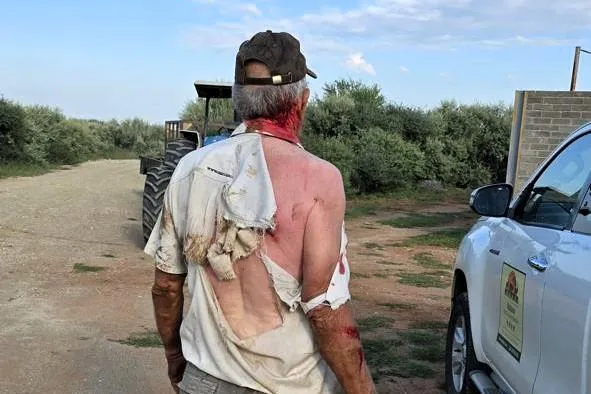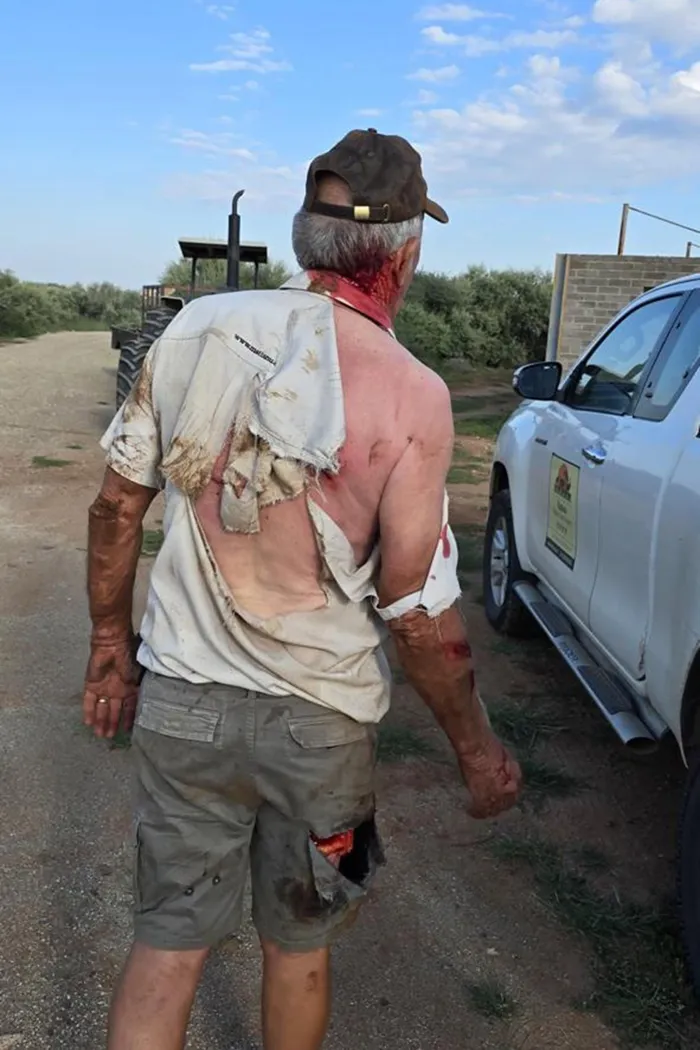Veteran Kimberley wildlife vet survives shocking Gemsbok attack

Dr Johan Kriek is seen following the attack, dazed and injured, with his clothing shredded beyond repair.
Image: Supplied
IN THE untamed wilderness of the Northern Cape, where the line between man and beast is often blurred, veteran wildlife veterinarian Dr Johan Kriek found himself in a perilous situation that served as a stark reminder of nature’s unpredictability.
Kriek, a highly respected expert in his field and the owner of Mattanu Wildlife Reserve near Barkly West, was in the midst of what should have been a routine operation – transporting a group of gemsbok. The animals had been sedated the previous day to ensure a smooth relocation process, and by all indications, they remained calm as the team prepared to load them. The gemsbok were being prepared for an auction that will be taking place on April 12 at Mattanu Wildlife Reserve.
With more than three decades of experience handling wildlife, Kriek was confident in his ability to manage the task safely. However, nature had other plans. As he reached for the horns of the last gemsbok cow, guiding her towards the transport vehicle, the seemingly docile creature reacted with sudden and violent force.
Before he could react, the powerful animal lashed out with her hooves, striking him hard at the back of his head and tearing into his leg with brutal precision. The impact left him dazed, his clothing shredded beyond repair. “You wouldn’t even be able to use my clothes as rags,” he later joked, attempting to lighten the severity of the encounter.

Dr Johan Kriek is seen following the attack, dazed and injured, with his clothing shredded beyond repair.
Image: Supplied
The injuries could have been far worse. Had the blow landed slightly higher, Kriek acknowledged, it could have severed a major artery, turning a dangerous encounter into a fatal one.
Despite his years of experience, the incident reaffirmed an undeniable truth: wild animals, no matter how familiar they may seem, remain unpredictable and should never be mistaken for domesticated pets. “No matter how well you know these animals or how long you’ve worked with them, accidents can happen in an instant,” Kriek said.
Social media quickly picked up on the incident, with images of Kriek’s injuries spreading rapidly online. Some speculated that the gemsbok had gored him with her horns, but Kriek clarified that protective black tubing had been placed over the horns to prevent such injuries. Instead, it was her powerful hooves that had inflicted the damage.
While still recovering from his wounds, Kriek hopes that his ordeal will serve as an important lesson. “This should be a wake-up call,” he urged. “Wild animals will always be wild, no matter how they are raised. People need to understand the risks involved in working with them.”
His words carry an especially strong warning for those who assume that male animals pose the greatest threat. “At some point, any wild animal will turn on you,” he cautioned.
For Kriek, the attack was a harsh but valuable reminder of the realities of his profession. Even with a lifetime of expertise, the wild remains unpredictable.
And in the Northern Cape’s rugged terrain, respect for nature isn’t just a principle – it’s a matter of survival.
Related Topics: